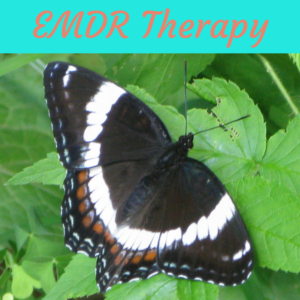
What is EMDR therapy?
EMDR stands for Eye Movement Desensitization and Reprocessing therapy.
It is named this because eye movements, and other bilateral stimulation (which is stimulation of both hemispheres of the brain through alternating left-right stimulation), help upsetting memories and emotions become less intense and get fully processed.
EMDR therapy began in the late 1980’s when the founder, Francine Shapiro, accidentally discovered that her upsetting thoughts became less intense during walking and when her eyes moved back and forth. After testing out eye movements with people in therapy over the course of a few years and receiving positive feedback from many of the clients, Francine Shapiro created a structured type of therapy that has become well-regarded and is viewed as one of the most efficient therapies, especially for trauma and PTSD.
During an EMDR session, the therapist guides the client by asking the client to observe thoughts, feelings, and sensations while providing one of the following types of bilateral stimulation:
- Following the therapist’s finger movements with one’s eyes
- Holding devices called pulsars or “tappers” that alternate light buzzing sensations in each palm
- Alternating taps on one’s knees with their fingers
- Using headphones to listen to tones alternating in each ear
- Alternating finger snaps near each of one’s ears
The client is encouraged to fully experience the thoughts, feelings, and sensations that arise. Even if one is not comfortable sharing these experiences with the therapist, just observing and allowing them to exist is enough for desensitization and reprocessing to occur.
It is thought that an upsetting memory or emotion is fully processed once no new images or associations come up when the client thinks about it. Usually such a memory or emotion becomes distant, as if one is viewing it from afar rather than feeling as if one is re-living/re-experiencing it.
Through the EMDR process, clients are encouraged to reflect on the negative beliefs, feelings, and sensations they associate with the memories being explored and the positive beliefs, feelings, and sensations they desire instead. Once the upsetting memories have been fully processed, clients usually attain the positive beliefs, feelings, and sensations they wanted. In the least, the memory is no longer negatively charged so becomes neutral.
It is important to note that a well-trained EMDR therapist will spend time building rapport and focusing on helping clients build healthy coping skills to ensure that they have the tools in place to fully deal with the upsetting memories and emotions that will be explored during EMDR therapy. Thus, do not be surprised if you are seeking EMDR therapy but do not get to try it in the first or even first several sessions.
It is also important to note that EMDR focuses on the present and future in addition to helping people make peace with their pasts. An important part of EMDR is to also address handling present triggers of past situations in a healthy manner and to make plans and build confidence in regards to handling future difficult situations.
How does EMDR therapy work?
The exact reasons why EMDR lessens upsetting memories and emotions are not known, but many studies have been done to observe its effects and have proven that it is one of the most efficient types of therapy.
To understand the reasons it is thought that EMDR works, we must first understand how upsetting experiences get processed in the brain. When something traumatic or disturbing occurs, our brains don’t know how to make sense of it. A neutral or happy experience gets processed in the brain in an organized and comprehensive way that usually allows us to recall the memory of it with clarity and in a linear fashion. A traumatic or disturbing experience, however, doesn’t get fully processed in the brain (see this blog article for details about this). This shows up as fragmented memories, memories that are based on sensory experiences (e.g. recalling snippets of certain sights, smells, or sounds that were experienced), and memories that get locked in body parts. It’s kind of like an undigested meal sitting in your stomach that’s causing you indigestion.
It is thought that the bilateral stimulation that occurs during EMDR accesses the parts of the brain and body where traumatic memories get stored in a way that just talking about memories can’t do. Once those parts are accessed, they can be explored in the safe setting of the therapy space so that they can be processed in a healthier, more complete way.
It is also thought that disturbing experiences get locked into short-term memory, which is why people often experience flashbacks and feel as if they are constantly re-living the upsetting experiences. EMDR helps those short-term memories get integrated into the long-term memory so that it no longer feels like it is happening in the present.
For more information about EMDR, you can read about it here and here.
Who benefits from EMDR therapy?
People of all ages benefit from EMDR therapy. Because memories and emotions can be visual, in the body, and otherwise non-verbal, EMDR can even be beneficial for young children and people with memory or other brain issues.
EMDR therapy has been shown to help with a variety of symptoms and issues, such as:
- Trauma and PTSD
- Anxiety
- Depression
- Phobias
- Grief
- Chronic pain
- Relationship issues and attachment issues
- Low self-esteem and negative beliefs about oneself
For teens
Teens are often able to explore their memories, emotions, beliefs, and sensations in much the same way that adults do during EMDR.
When I do EMDR with teens, I mix it with talk therapy and drama therapy.
For adults
Adults typically find the process of EMDR to be comfortable, as it doesn’t feel much different than talk therapy in the sense that one tends to verbally share the thoughts and feelings one experiences during it. It may actually feel more comfortable than traditional talk therapy, as one is not required to share their experiences in detail in order to experience the healing process.
Although I tend to talk more with adult clients during sessions, I still mix drama therapy with EMDR during sessions as well.
Contact me
To see if EMDR therapy would be a good fit for you or your child, contact me for a free 15 minute consultation.
